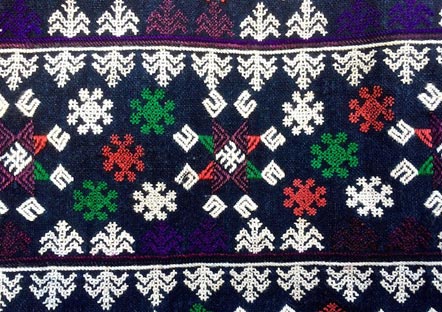Red Dao ethnic group in Sapa still remains much traditional custom and unique technique in embroidery. Embroidery of Red Dao is preserved and developing through tourism by open embroidery classes.
Take part in Red Dao ethnic embroidery class

Tamay, 45, and mother of 3 is one of the many ethnic minority women employed at Ethos Spirit of Community for her traditional textile expertise and local knowledge.
Tamay’s house was a simple structure perched on the precipice of the hill over looking the valley and neighboring Red Dao families below. It was made from wooden planks with a huge open plan interior that had a wood stove fire in the middle of the room for cooking. There were out houses providing shelter for small livestock, vegetable and fruit plantations, an outdoor toilet and herbal bath.
Exceptional Ethnic Embroidery

Embroidery skills are extremely important in ethnic minority life. No Red Dao women is seen as fit to marry or even desirable until she has sewn her own clothes. Tamay started learning from her mother at the age of 7 and is now considered one of the most accomplished and respected artisans in her community. Designs representing village life and animist mysticism such as stars, trees, rice terraces and family are meticulously stitched in silk with pin point precision. Every new year it is the wife’s duty to make a new set of clothes for her husband and children in time for Tet holiday at the end of January. Each Red Dao traditional dress includes a intensely embroidered knee length jacket, trousers, belt, necklace and head dress, consuming all their free time after chores for the whole year round.
The Traditional Technique

Don’t even know how to explain how complicated and time consuming Red Dao embroidery is. The process starts by dividing the silk threads into 3s and twisting them together between the skin on your knee and the palm of your hand. Each stitch is sewn in and out of the tightly woven warp and weft threads in a black cotton fabric. Tamay and her peers must have the eye sight of an eagle as not a single stitch is in the wrong place. Ever. The symbolic motifs and patterns are sewn from the reverse side of the fabric and the sequence of the stitches used to create the design is recalled from memory. It is not simply cross stitch. It took over 3 hours for me to sew that one tree
Textile Tours
It’s one thing to look and admire a piece of textiles for sale in a shop or from a street vendor but it’s another to spend a day with the person that made the product to practice their craftsmanship for yourself. To book your day with Tamay contact Ethos Spirit of Community direct.
